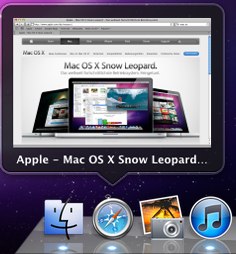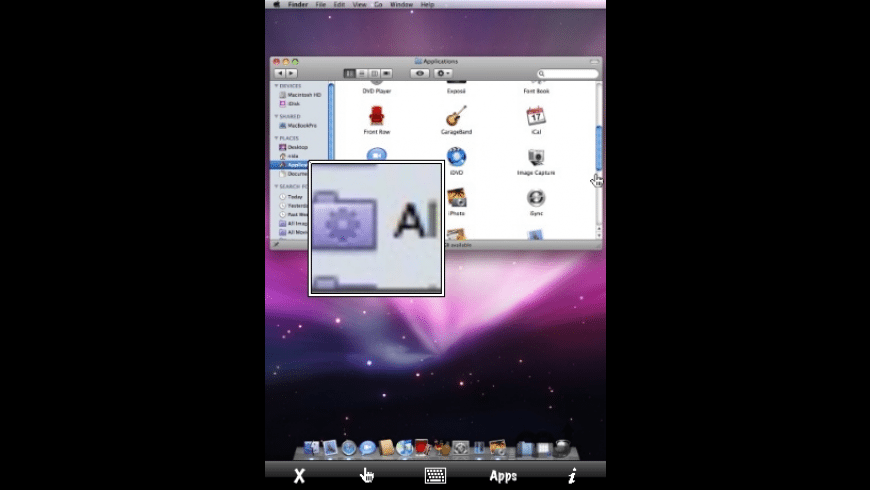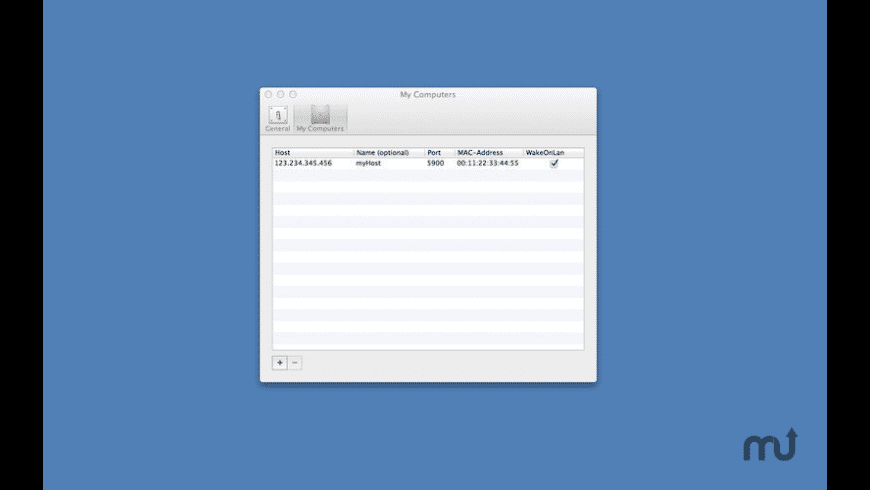ScreenSharingMenulet hits 2.0. Twitter Facebook Reddit Mail. Load More Articles; Sponsored Links. About Engadget About our Ads Advertise Brand Kit Buyers. I know this won't work in all cases, but for the other computers on my home network, there's the even easier built-in way of doing this. In the finder, in the sidebar, other computers on the network show up under 'Shared', and it's only two clicks to open a screen sharing session.
| Click here to return to the 'Using VNC from the Terminal' hint |

You can do the same from the Finder:
Go->Connect to Server. Or Command-k.
Type in the same 'vnc://...' as above (without the 'open' part). You can save connection shortcuts here also.
And of course, the 'open' command can be used to open anything that LaunchServices can - files, applications, URL's, and optionally specify the app to open them with. Very powerful command - even if this is a bit of an odd use for it.
You can do all you describe, or just go to the Finder (Command-Tab: 2), Connect to Server (Command-K: 4), navigate to your favorite server, and connect (Enter: 5). There - 5 keystrokes from Terminal to connecting, and no aliases or shell machinations, and it works from any app - since you're command-tabbing to the Finder first. It would be much nicer if Screen Sharing.app would bring up your favorite VNC locations when launched from the Dock, but sadly a trip to the Finder is necessary. You could always put those favorites on the Dock as well, but then you'd lose out on keyboard access.

Screen Sharing Menulet
This doesn't work if your VNC server is on a nonstandard port. I serve multiple VMs from one server, so I have to put each on a different port, and I can't access them this way.
I tried 'open vnc://192.168.1.30:9001' to no avail.

Strange. I use a non-standard port when I'm running vnc over an ssh tunnel and that syntax has always worked fine for me.
I know this won't work in all cases, but for the other computers on my home network, there's the even easier built-in way of doing this.
In the finder, in the sidebar, other computers on the network show up under 'Shared', and it's only two clicks to open a screen sharing session. One on the computer in the sidebar, one on the 'share screen' button that subsequently shows up.
I believe that there was some initial setup for this, but now it's just a matter of a couple clicks.
I just type vnc://blah.tld.com into the safari location bar and it launches screen sharing.
...me too. Even better, you can drag the location from the safari location bar and drop it on your desktop to create a convenient shortcut!
Excellent! TVM for the hint. (Just got a Mac Mini, so was looking for a quicker way to launch VNC/Screen Sharing.)
Yep, and you can save them as bookmarks in Safari. I've done that, then use LaunchBar to open them quickly.
don't forget that you can embed the authentication like this
vnc://username:password@ipaddressordomain
if it's a mac that you are remoting into. Setting them up as a shell alias is one way to do it. Storing them in Safari's bookmarks and the authentication in your keychain is another. Since I mostly work graphically and seldom in terminal, I put all my remote control links in a folder in my bookmarks bar. This has the side effect of also making them available on my iPad, and since I have iTeleport on my iPad the links work from there too.
And to the other poster, it is extremely easy to view the contents of the file. Just type
cat file in the terminal. Actually, there's really no need to examine the file anyway, since it has the password in there, anyone who wants to use it just needs to open it (if they are on a Mac). For the more GUI-inclined, try a free utility called Screen Sharing Menulet
http://www.klieme.com/ScreenSharingMenulet.html
It sits in the menu bar and automatically shows any Macs on the local subnet with screen sharing enabled. You can also add other computers by IP address. As a Mac administrator, I find it invaluable for quick remote access for troubleshooting.
I don't remember where I got it from (maybe here on macosxhints?), but here is my favorite solution: just drag the folder ~/Library/Application Support/Screen Sharing to the dock.
(This folder contains a file with extension .vncloc for each machine that you have accessed for screen sharing)
Click once to show the machines you've used Screen Sharing with; click a second time to select the one you want and there you go.
Seriously? 'on OSX'? For one thing, it's 'OS X,' and for another, this is Mac OS X hints, which should imply that anyway.
Quicksilver is dead, long live Quick Search Box: http://code.google.com/p/qsb-mac/
Really? What am I using then?
No need to be a jerk.
As far as I knew, QSB was the successor to QS. Thanks to your snide comment and some searching around on my part, I now know that QS has moved from its long-hosted blacktree location <http://www.blacktree.com/projects/quicksilver.html> and now exists as github project <http://github.com/tiennou/blacktree-alchemy>.
A bugbear of mine about this site is the use of absolute statements based on personal experience or personal preference. I'm sorry, I thought your comment was based on the latter.
<blockquote>just drag the folder ~/Library/Application Support/Screen Sharing to the dock.</blockquote>
Except ~/Library/Application Support/Screen Sharing does not exist on my Mac OS X 10.5.8. Any idea why?

Have you used Screen Sharing to connect to another Mac? The folder is created the first time used.
Screen Sharing Menulet
Thanks Rich,
sure I use it on a daily basis (hence my desire to improve the abysmal poor user interface).
I run on 10.5.8 and the application has not created such a folder. The screen sharing app used to remeber a list of visited serves, but at some point (with some action or update) this disappeared. All I have now is Apple+N to start a small dialog for the server I want to connect to.
I did create such a folder myself and added *.vncloc files with the vnc:// URl in ot but that does not work either.
I'm on 10.5.8 and this does not work.
What works is type vnc://mypc.example.com/ into safari and drag the little icon into a folder in finder. This creates a file named vnc--mypc.example.com.inetloc with some binary content.
If you like you can drag the folder with such *.inetloc shortcuts to the dock in order to show as a fan or grid.
Safari can directly handle vnc:// URIs. Also, you can directly use the Finder (under Go > Connect to server...) to save your vnc:// URIs, where you can optionally store credentials to those vnc servers in your keychain.
ScreenSharingMenulet connect to local, Back to My Mac and custom hosts via Screen Sharing from the menu bar |

Starting with version 2.5 ScreenSharingMenulet is available only on the Mac App Store
Minimum Requirements:
• Intel Mac
• Mac OS X 10.6 Snow Leopard or later
Features:
• Real-time search for available local and Back to My Mac hosts.
• Option to create custom non-local hosts with host, displayed name and port.
• Option to display custom hosts inline or in a submenu.
• Optional display of Back to My Mac hosts and local IP addresses.
• Optional disable the Bonjour browser.
• AppleScript support.
• Export/Import of custom hosts.
• Retina display support.
• Wake On Lan (WoL) for custom hosts.
• German, Dutch, French and Swedish localization.
How to use:
• Just select one of the displayed hosts to connect via Screen Sharing.
• Create custom hosts in the pane 'My Computers' of the preference panel and choose them from a submenu (or optional from the main menu).
• Enable WoL in the pane 'My Computers'. A valid hardware address (primary Ethernet MAC-Address, format 11:22:33:44:55:66) must be specified.
• You can add ScreenSharingMenulet to the login items in the preference panel.
Hint:
If you want to connect temporarily to a shared host, create a new entry in the preference panel leaving the host field blank.
In this case the 'Connect to Shared Computer' dialog box of Screen Sharing.app will open.
Notification Center:
By default the bonjour hosts are not shown in Notification Center when ScreenSharingMenulet is launching or the bonjour browser is restarting.
If you want to be notified about all bonjour host changes, type in Terminal.app
defaults write com.klieme.ScreenSharingMenulet SkipBonjourNotificationOnRestart -bool NO
Wake On Lan:
As sleeping hosts don't appear in the local hosts section, WoL is available only for custom hosts.
Automatically detected hosts in the local hosts section can be added to the custom hosts by selecting the menu item while pressing the option-key.
After sending the WoL packet the connection can take some time, ScreenSharingMenulet waits for the notification when the target host is awake.
Note: On pre Snow Leopard systems WoL works only on wired computers.
See the article About Wake on Demand to enable Wake on Demand in Snow Leopard.
AppleScript example:
tellapplication 'ScreenSharingMenulet'
setnewServicetomakenewcustom serviceatendofcustom serviceswith properties {host:'111.222.333.444', name:'MyHost', port:5900}
connecttonewService
endtell
Known Problems:
The connection to Back to My Mac hosts is not reliable. It depends on router hardware and firewall settings.
Even if the password is correct an error message could occur. It has been tested with Apple Time Capsule and Apple Airport Express base stations.
Version Compatibility:
• ScreenSharingMenulet 1.7.1 and higher is compatible to Mac OS 10.6 Snow Leopard.
• ScreenSharingMenulet 2.2 and higher is compatible to Mac OS 10.7 Lion and Mac OS 10.8 Mountain Lion.
